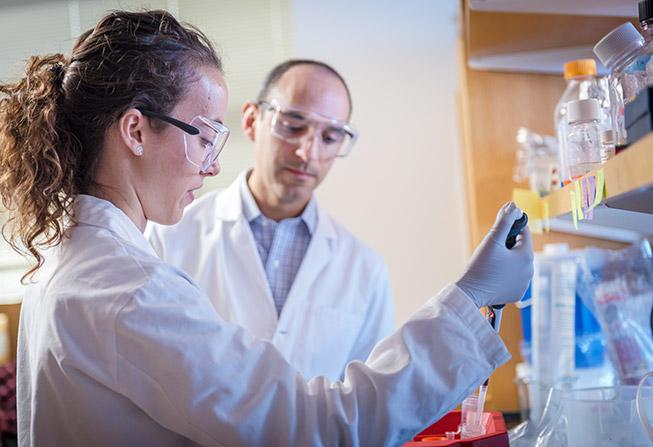Commitment to Pure Science
The same attention to the underlying conditions that lead to outstanding research applies to the Institute’s support of "pure science." Research undertaken to answer basic biological questions, while recognizing the inherent value of empirical efforts to expand knowledge, requires an environment in which free, interest-fueled inquiry is encouraged. Dana-Farber’s success in creating such an environment is reflected in the countless advances in the understanding of cellular and systemic processes that have occurred in our laboratories. The commitment to curiosity-driven research remains undiminished even as the Institute integrates basic, translational, clinical, and population sciences research into a well-functioning transmission system for scientific progress against cancer.
Dana-Farber’s strategic investment in research is realized through creating a cadre of established scientific leaders and talented young investigators, acquiring technology at the leading edge of cancer research, encouraging collaboration among the faculty, providing resources in support of promising work, and ensuring a presiding spirit of innovation, which is the Institute’s legacy. The result is an intense scientific impact on a group of diseases that continue to represent one of humanity’s greatest health challenges.
Research Preeminence
What most distinguishes Dana-Farber’s science, perhaps, is the preeminence of our investigators and the extent of their collaborations. Dana-Farber's scientific community includes nationally recognized leaders in fields across the spectrum of cancer research, including dozens of scientific journals and cancer textbooks, Howard Hughes Medical Institute investigators, officers of professional associations, and authors of some of the most often-cited research papers of the past decade. Others are scientific advisors to advocacy organizations, featured speakers at scientific conferences around the world, award-winning mentors, and elected members of professional organizations, including the National Academy of Sciences, the American Academy of Arts and Sciences, and the Institute of Medicine.
A key index of scientific stature is Dana-Farber’s success in external peer-reviewed funding. The Institute continues to be one of the highest recipients of grant funding from the National Cancer Institute, an accomplishment that is particularly impressive considering our relatively small faculty base. Moreover, Dana-Farber scientists compete successfully for grants from such noted foundations as the Leukemia and Lymphoma Society, American Cancer Society, Bill and Melinda Gates Foundation, Susan G. Komen for the Cure, Doris Duke Charitable Foundation, Tisch Family Foundation, and Robert Wood Johnson Foundation.
Leadership in Clinical Trials
Dana-Farber also has one of the largest cancer clinical trials programs in the country, with over 1,100 clinical trials. Importantly, more than one-quarter of these studies are investigator-initiated and one-third are Phase I or I/II, demonstrating our commitment to translate basic research findings to the clinic through proof-of-principle and early phase studies.
Collaborative Environment
The achievements of our faculty are in part due to a special environment, where collaboration is intrinsic to the way Dana-Farber researchers work. Tangible evidence of this is the number of NIH Specialized Projects of Research Excellence (SPORE) grants and Program Project Grants awarded to Dana-Farber. It is the responsibility of the Institute’s Chief Scientific Officer, Barrett J. Rollins, MD, PhD, to develop the tools and resources that Dana-Farber’s faculty need to realize their research vision, and to provide an environment that supports and rewards collaboration.
This invigorating environment is furthered through scientific partnerships with other research centers. The most significant of these is Dana-Farber/Harvard Cancer Center (DF/HCC), the largest NCI-designated Comprehensive Cancer Center in the country. DF/HCC comprises more than 1,000 cancer researchers at Dana-Farber and six other Harvard-affiliated institutions who are working together with a singular goal — to find new and innovative ways to combat cancer. A related collaboration has been established between scientists at DF/HCC and the University of Massachusetts Boston (UMB). The UMB-DF/HCC Comprehensive Cancer Partnership Program enhances research in health disparities and improves research, training, and outreach opportunities for minority students, fellows, and scientists.
In addition, Dana-Farber faculty access resources and scientific expertise in highly specialized fields through the Institute’s associations with the Harvard Stem Cell Institute, Harvard’s NIH Clinical and Translational Science Center, and the Broad Institute, a center of genomic research where several Dana-Farber faculty members have joint appointments. Established partnerships with pharmaceutical manufacturers have facilitated the development of new cancer drugs. Lastly, faculty enjoy the robust clinical care, clinical research, and training opportunities made possible through long-standing hospital alliances, including Dana-Farber/Boston Children’s Cancer and Blood Disorders Center, Dana-Farber/Brigham and Women’s Cancer Center, and Dana-Farber/Partners CancerCare.
Looking Forward
The forward-looking nature of research at Dana-Farber is embodied in the Institute’s commitment to developing the next generation of cancer science leaders. Dana-Farber faculty are recognized for their excellence in medical education, research training, and clinical training. At Harvard Medical School, Harvard School of Public Health, and Harvard College, our researchers teach graduate and undergraduate courses in basic biomedical and related sciences. They also serve as mentors for predoctoral and postdoctoral trainees at Harvard and Harvard-affiliated institutions.
Building upon a determination to increase the pipeline of future cancer researchers, the Institute supports training programs with high schools, colleges, and community groups that enable underserved students to work in Dana-Farber laboratories and begin their careers in science. Our adult and pediatric oncology fellowship programs, operated in conjunction with Boston Children’s Hospital, Brigham and Women’s Hospital, and Massachusetts General Hospital, are among the most sought-after opportunities for aspiring cancer physician-scientists.
The combination of careful mentoring and encouragement of novel research projects has produced a corps of graduates who today are principal investigators and institutional leaders at cancer centers around the world. This same blend of opportunity and guidance has spurred the careers of countless scientists who trained at Dana-Farber as postdoctoral fellows and graduate students.
Ultimately, Dana-Farber’s support of the scientific enterprise is driven by strategic thinking and ground-level pragmatics. We have acquired the capabilities to answer the next generation of questions in cancer research. The unrivaled combination of resources and expertise available to Dana-Farber researchers ensures that the Institute will continue to lead for years to come.
